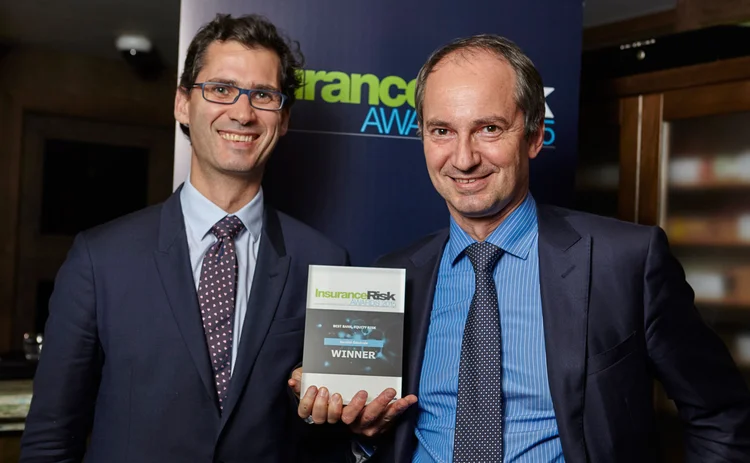
Best bank, equity risk: Societe Generale
Insurance Risk Awards 2015: SG's ability to take on equity risk sets it apart from competitors, as does the firm's work on variable annuities and risk premia indexes

The launch of quantitative easing (QE) by the European Central Bank earlier this year contributed to a rise in equity markets, lifting the EuroStoxx 50 by around 15% between the QE announcement in January and the middle of April. UK insurers, in particular, responded by increasing allocations, with the attendant need to hedge market risk.
It was a move that didn't work out as insurers had hoped, with volatility after QE higher than they expected, and those hedges proved valuable when markets slumped later in the summer. Before then, however, the rally meant a busy first-half for Societe Generale (SG), which worked with clients as they upped holdings and put on large trades, including four with notionals of more than €1 billion ($1.2 billion), according to Eric Viet, head of financial institution advisory at the bank, who estimates that insurance clients increased equity allocations by about two percentage points over the period.
Some of this activity was relatively straightforward, he says, with Solvency II limiting the options for insurers hedging equity because any basis risk between the underlying holdings and the hedge could reduce the capital relief they get. However, the bank did see an increase in clients funding their equity hedges (typically a put option on the relevant index) by selling short-dated calls on a different index to take a view on the relative performance of the benchmarks.
More broadly, insurers report a willingness from SG to take equity risk on its books that sets the bank apart from peers. And internalising trades is central to being able to do this, says Viet, helped by the bank's strength in structured products and close links with hedge funds.
In a situation such as the one over the summer when equity markets fell, a bank with only institutional clients might find itself constrained, Viet says. "It is powerful to be able to recycle positions inherited from our retail business with hedge funds or institutional investors," he adds. "If you have only one side of the trade, you are going to reach your maximum trading capacity pretty quickly."
If you have only one side of the trade, you are going to reach your maximum trading capacity pretty quickly
"In the retail space you have seen lots of autocallable product being issued," he notes, by way of example. "The equity market falls during the summer created a massive shift in volatility smile sensitivity and, being able to unwind those positions with hedge funds, helped us to risk-manage our exposure. That makes a more scalable business."
SG can also point to individual examples of innovation, such as the development for a continental insurer of an exchange-traded fund (ETF) structure combining volatility controls, Solvency II capital optimisation and tax efficiency. SG created an ETF referencing a bespoke equity index with a put option on the ETF to reduce the insurer's Solvency II solvency capital requirement.
The index is rebalanced monthly based on a predefined algorithm, but taking into account local tax rules, which allow the insurer to avoid capital gains tax on shares held for longer than a year. Meanwhile, the ETF wrapper means the client can apply hedge accounting to the put option in the structure.
Outside Europe, meanwhile, the bank has built a market-leading team advising Japanese insurers on the development of variable annuity (VA) products, with a team of seven specialists based in Tokyo and nine in Hong Kong. The bank combines its trading expertise and asset management capabilities and draws on its in-house reinsurer Catalyst Re to help design, reinsure and hedge products for insurers offering variable annuities.
Already the bank provides hedging solutions to half the top 10 insurers in the market in Japan, with more than ¥1.2 trillion ($9.8 billion) guaranteed minimum death benefits reinsured and more than ¥1.2 trillion guaranteed minimum accumulation/income benefit guarantees reinsured. Seventeen VA funds are invested in SG customised VA indexes, including, this year, funds for Dai-ichi Frontier Life and Mitsui Sumitomo Primary Life.
SG hopes to leverage this expertise, as the European market for guaranteed products develops, Viet says. UK pension reforms have reduced the need for annuity products in the UK. And in Germany, insurers are moving away from providing traditional guaranteed policies. But, while "a dream" for insurers, Viet doubts that relying on unit-linked policies will satisfy customer demands.
"There is a space for products that are fully guaranteed because some customers won't want to take on risk," he says. "Variable annuities are going to be part of the answer."
Meanwhile, also looking to the future, the bank has developed the SGI Risk Premia Index, a basket of investible risk premia strategies that it hopes will appeal to insurers searching for yield. Under the Solvency II standard formula the Risk Premia Index would attract the standard solvency capital requirement charge of 49% for unlisted equities, but SG says with individual analysis of the underlying strategies the overall charge can be reduced by 30-60% depending on the risk composition of the index. During the past year SG won a mandate from a US pension plan using the index, with a leading US life insurance company now also looking to invest in the product for its own account.
Only users who have a paid subscription or are part of a corporate subscription are able to print or copy content.
To access these options, along with all other subscription benefits, please contact info@risk.net or view our subscription options here: http://subscriptions.risk.net/subscribe
You are currently unable to print this content. Please contact info@risk.net to find out more.
You are currently unable to copy this content. Please contact info@risk.net to find out more.
Copyright Infopro Digital Limited. All rights reserved.
As outlined in our terms and conditions, https://www.infopro-digital.com/terms-and-conditions/subscriptions/ (point 2.4), printing is limited to a single copy.
If you would like to purchase additional rights please email info@risk.net
Copyright Infopro Digital Limited. All rights reserved.
You may share this content using our article tools. As outlined in our terms and conditions, https://www.infopro-digital.com/terms-and-conditions/subscriptions/ (clause 2.4), an Authorised User may only make one copy of the materials for their own personal use. You must also comply with the restrictions in clause 2.5.
If you would like to purchase additional rights please email info@risk.net
More on Insurance
The future of life insurance
As the world constantly evolves and changes, so too does the life insurance industry, which is preparing for a multitude of challenges, particularly in three areas: interest rates, regulatory mandates and technology (software, underwriting tools and…
40% of insurers fail to specify climate as a key risk – LCP
Despite regulators’ urging, many UK and Irish insurers omit climate from risk statements, says report
Libor leaders: Prudential takes SOFR for a test drive
Test trades have allowed US insurer to start getting used to a life without Libor
Fed to push ahead with capital regime for single US insurer
Prudential faces risk capital add-ons unless it sheds “systemically important” label
Brexit dims hopes for Solvency II change in UK
Lawyers say political tensions may have killed off chance of reform, following PRA U-turn
BoE creates volatility adjustment ‘stepping stone’ for insurers
Dynamic VA may be used for assets that fail to qualify for matching adjustment, say experts
No plans to scrap systemic insurer rules, says IAIS chair
A US regulator claims Europeans asked IAIS to chart own course after FSB moved to ditch G-Sii list








